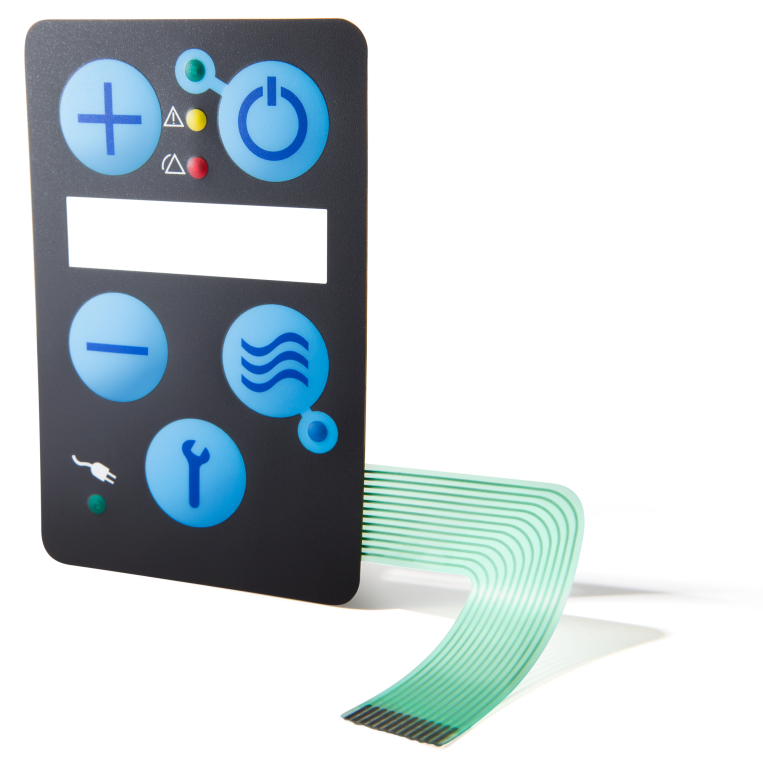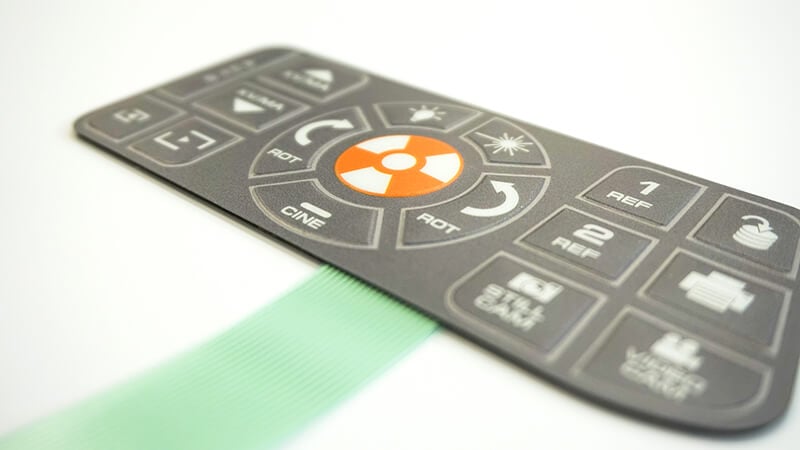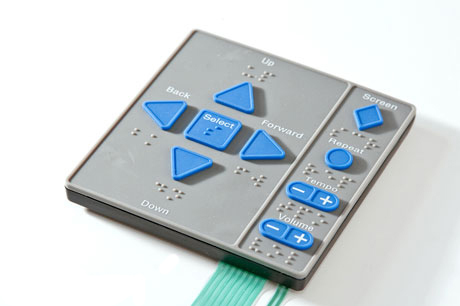Advanced Technology from a Top Membrane Switch Manufacturer
Understanding the Value of Membrane Switch in Modern Electronics and Their Applications
Membrane switches act as an important element in modern-day electronic devices, using a reliable interface for individual communication. Their lightweight and personalized nature makes them appropriate for a variety of applications throughout varied industries. Comprehending their essential parts and advantages can provide understandings right into their expanding significance. As technology remains to advancement, the evolution of Membrane changes elevates inquiries about their future applications and style developments. What exists ahead in this dynamic field?

What Are Membrane Switches?
Membrane buttons are vital components in contemporary electronic devices, working as interface that facilitate communication in between gadgets and customers. These switches include a number of layers, including a visuals overlay, a sticky layer, and a circuit layer, every one of which collaborate to develop a useful and durable user interface. The style allows for a flat, low-profile remedy that can be personalized pertaining to size, form, and aesthetic look, making them suitable for different applications, from customer electronic devices to medical gadgets. The responsive feedback given by Membrane switches improves customer experience, while their resistance to dust and wetness makes them ideal for challenging atmospheres. Membrane buttons can include attributes such as backlighting and printed graphics, even more broadening their functionality. Their flexibility and effectiveness make them a preferred choice in sectors where integrity and convenience of usage are extremely important, inevitably adding to the smooth procedure of modern-day digital tools.
Trick Parts of Membrane Switches
While different parts add to the capability of a membrane switch, three main layers play considerable functions in its style and operation. The top layer, normally made from a sturdy polymer, offers as the user interface for customer interaction, frequently including published symbols and graphics. Beneath this is the spacer layer, which maintains the necessary range in between the top layer and the circuit layer. This spacer layer guarantees that the button turns on only when pushed, stopping unintentional inputs. The circuit layer includes conductive traces that complete the electrical circuit when the leading layer is dispirited. These traces can be made from different materials, consisting of copper or silver. Together, these components produce a durable and dependable gadget that is portable and flexible, suitable for a wide variety of digital applications, from home devices to medical devices. Recognizing these essential components is important for appreciating the overall performance of Membrane switches.
Benefits of Utilizing Membrane Switches

Membrane Switch Production Process
Recognizing the Membrane button production procedure exposes the intricate steps entailed in creating these important parts. The procedure typically begins with the style phase, where specs and layouts are created making use of specialized software. Following this, the graphic overlay is published on a versatile substratum, typically using high-resolution printing strategies to ensure quality and precision.Next, the adhesive layers are applied, which offer to bond the numerous components together. The circuit layers, made from conductive inks or materials, are after that printed onto a separate substratum. These layers are carefully straightened and laminated flooring to develop a useful switch.After setting up, the buttons go through examining to verify performance and resilience. Quality assurance measures are carried out throughout the process to identify and rectify any flaws. The completed Membrane switches are packaged and prepared for distribution, prepared to fulfill the needs of modern-day electronic applications.
Applications of Membrane Switches in Various Industries
Membrane switches are progressively made use of across different markets, particularly in medical devices and customer electronic devices. In the clinical area, they provide reliable control interfaces for devices that call for exact operation. Likewise, in customer electronic devices, these buttons improve individual communication by using streamlined and receptive interfaces.
Medical Devices Control
Numerous modern clinical tools make use of Membrane buttons for structured procedure and improved individual interaction. These switches supply a reliable, resilient user interface for a selection of applications, consisting of analysis tools, patient monitoring systems, and surgical instruments. Their adjustable layouts permit details formats that can fit the unique demands of health care professionals, making certain user-friendly navigating and efficient accessibility to necessary functions. In addition, Membrane buttons are immune to pollutants, making them appropriate for sterile atmospheres. The responsive comments they use can improve individual confidence, lowering the risk of mistakes during crucial clinical procedures. In general, the combination of Membrane buttons in medical equipment considerably adds to enhanced operational effectiveness and patient security in medical care settings.
Customer Electronics Interfaces
In the domain of customer electronics, Membrane buttons play a critical function in boosting individual interfaces throughout a broad array of gadgets. These buttons are integral to items such as remote controls, microwaves, and video gaming consoles, offering a user-friendly and reliable interface. Their design enables for a smooth combination of graphics and functionality, allowing suppliers to create smooth, modern-day visual appeals without endangering usability. Membrane switches are likewise understood for their longevity, frequently withstanding extensive use and direct exposure to different environmental conditions. Furthermore, they can integrate attributes like backlighting and tactile feedback, further boosting the individual experience. As consumer needs for innovative yet instinctive user interfaces grow, Membrane switches continue to be a crucial part ahead of time electronic tool performance.
Design Considerations for Membrane Changes
Creating effective Membrane switches over calls for mindful interest to various variables that affect both performance and customer experience. One crucial consideration is the selection of products, as they can influence longevity, responsive responses, and visual charm. Selecting an appropriate adhesive is essential for assuring long-term adhesion and resistance to ecological factors.In enhancement, the design and style of the switch have to accommodate customer communication, with button dimensions and spacing enhanced for simplicity of use. The unification of graphics and labeling ought to focus on clarity and presence under different illumination conditions.Consideration of electric attributes, such as actuation force and switch level of sensitivity, will enhance the responsiveness of the Membrane switch. Furthermore, the style ought to accommodate making processes to guarantee cost-effectiveness and prompt manufacturing. On the whole, a well-thought-out layout improves both the customer and the functionality experience of Membrane switches in modern-day electronics.

Future Patterns in Membrane Switch Technology
As innovation remains to advance, Membrane switches are poised to integrate brand-new innovations that will enhance their performance and application in different fields. One considerable fad is the incorporation of sturdy and adaptable materials, which will enhance the life-span and reliability of these switches. Boosted surface area textures and adjustable graphics are likewise expected, allowing for even more intuitive individual interfaces.Moreover, the assimilation of smart technology, such as touch-sensitive surfaces and haptic responses, is anticipated to boost individual interaction, making Membrane switches much more responsive and engaging. In addition, breakthroughs in published electronics will certainly make it possible for more complex circuitry within thinner profiles, additionally increasing style possibilities.Sustainability will additionally play a crucial duty in future developments, as suppliers discover environment-friendly materials and production processes. In general, these patterns will certainly ensure that Membrane switches over continue to be pertinent and indispensable in a her comment is here increasingly electronic and interconnected globe.
Frequently Asked Concerns
Exactly How Do Membrane Changes Contrast to Traditional Mechanical Switches?
Membrane changes deal benefits over conventional mechanical switches, consisting of decreased dimension, lighter weight, and enhanced durability. They typically give a secured surface area, improving resistance to dust and dampness, making them excellent for diverse applications.
What Products Are Typically Used in Membrane Switch Building And Construction?

Can Membrane Switches Over Withstand Extreme Environmental Conditions?
Membrane switches can stand up to extreme environmental problems, depending upon their layout and materials. High-grade building and constructions frequently include longevity versus temperature level fluctuations, humidity, and direct exposure to chemicals, making them appropriate for different requiring applications across industries.
Just How Long Do Membrane Switches Usually Last Before Failing?
Membrane switches over generally show a lifespan varying from 1 to 10 million actuations, depending upon factors such as use frequency, environmental conditions, and manufacturing top quality. Routine upkeep can extend their durability and operational reliability considerably.
Are Membrane Changes Customizable for Details Applications?
Membrane buttons are without a doubt adjustable for certain applications. They can be tailored in functionality, size, and design, allowing producers to meet special customer needs and enhance item appearances while maintaining functional effectiveness and durability. Membrane switches are important components in modern-day electronics, offering as individual interfaces that facilitate interaction between gadgets and users. The image source tactile feedback offered by Membrane switches boosts customer experience, while their resistance to dust and wetness makes them optimal for testing atmospheres. The unification of graphics and labeling should prioritize clearness this and exposure under various illumination conditions.Consideration of electrical features, such as actuation force and button level of sensitivity, will enhance the responsiveness of the Membrane button. Enhanced surface area structures and adjustable graphics are also expected, permitting for more user-friendly customer interfaces.Moreover, the assimilation of clever modern technology, such as touch-sensitive surface areas and haptic comments, is anticipated to enhance user interaction, making Membrane switches over more appealing and responsive. Membrane switches over deal benefits over typical mechanical switches, consisting of lowered dimension, lighter weight, and improved longevity.